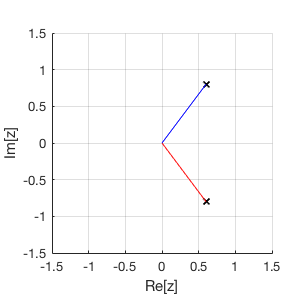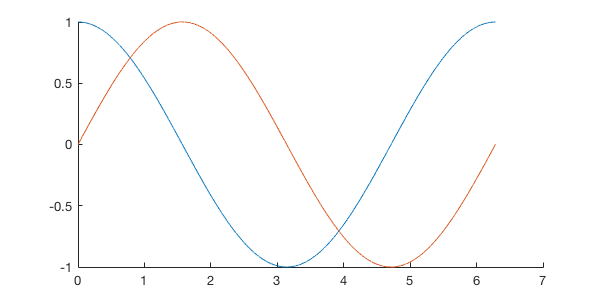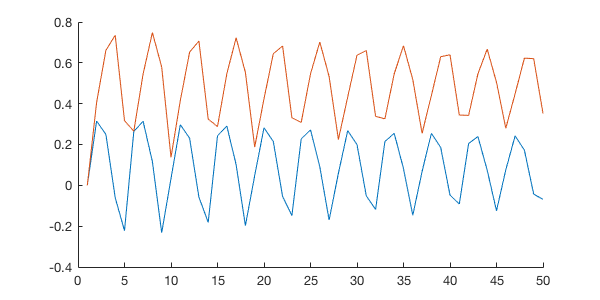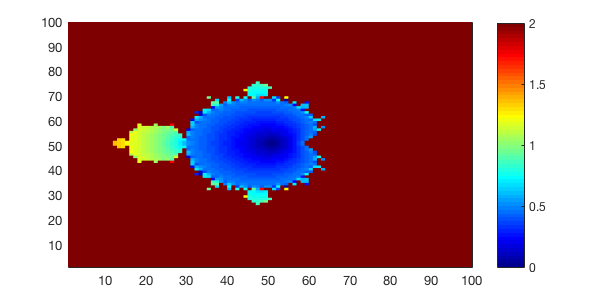Lecture 5: Random Numbers & Complex Numbers¶
Date: 09/14/2017, Thursday
In [1]:
format compact
Built-in random number generator¶
rand returns a random number between [0,1] (uniform distribution).
In [2]:
rand
ans =
0.8147
rand(N) returns a \(N \times N\) random matrix. You can always
type doc rand or help rand to see the detailed usage.
In [3]:
rand(5)
ans =
0.9058 0.2785 0.9706 0.4218 0.0357
0.1270 0.5469 0.9572 0.9157 0.8491
0.9134 0.9575 0.4854 0.7922 0.9340
0.6324 0.9649 0.8003 0.9595 0.6787
0.0975 0.1576 0.1419 0.6557 0.7577
randi(N) returns an integer between 1 and N.
In [4]:
randi(100)
ans =
75
randn uses normal distribution, instead of uniform distribution.
In [5]:
randn(5)
ans =
-0.3034 -1.0689 -0.7549 0.3192 0.6277
0.2939 -0.8095 1.3703 0.3129 1.0933
-0.7873 -2.9443 -1.7115 -0.8649 1.1093
0.8884 1.4384 -0.1022 -0.0301 -0.8637
-1.1471 0.3252 -0.2414 -0.1649 0.0774
Complex numbers¶
Complex number basics¶
A real number (double-precision) takes 8 Bytes (64 bits). A complex number is a pair of numbers so simply takes 16 Bytes (128 bits)
In [6]:
x = 3;
y = 4;
z = x+i*y;
In [7]:
whos
Name Size Bytes Class Attributes
ans 5x5 200 double
x 1x1 8 double
y 1x1 8 double
z 1x1 16 double complex
Take conjugate of a complex number:
In [8]:
conj(z)
ans =
3.0000 - 4.0000i
Show the number on the complex plane
In [9]:
%plot --size 300,300
hold on
complex_number_plot_fn(conj(z)/5,'r') % complex_number_plot_fn is available on canvas.
complex_number_plot_fn(z/5,'b')

3 equivalent ways to compute \(|z|\)
In [10]:
abs(z)
ans =
5
In [11]:
sqrt(dot(z,z))
ans =
5
In [12]:
norm(z)
ans =
5
The angle of z in degree:
In [13]:
angle(z) / pi * 180.0
ans =
53.1301
Euler’s Formula¶
Verify that MATLAB understands \(e^{i\theta}\)
In [14]:
theta = linspace(0, 2*pi, 1e4);
z = exp(i*theta); % now z is an array, not a scalar as defined in the previou section.
In [15]:
%plot --size 600,300
hold on
plot(theta,real(z))
plot(theta,imag(z))

Mandelbrot set¶
Iteration with a single parameter¶
In [16]:
c = rand-0.5 + i*(rand-0.5);
T = 50;
z_arr = zeros(T,1); % to hold the entire time series
z = 0; % initial value
z_arr(1) = z;
for t=2:T
z = z^2+c;
z_arr(t) = z;
end
In [17]:
hold on
plot(real(z_arr))
plot(imag(z_arr))

Run this code repeatedly, you will see sometimes \(z\) will blow up, sometime not, according to the initial value of \(c\). Thus we want to figure out what values of \(c\) will make \(z\) blow up.
Iteration with the entire paremeter space¶
We want to construct a 2D array containing all possible values of \(c\) on the complex plane.
Let’s make 1D grids first.
In [18]:
nx = 100;
xm = 1.75;
x = linspace(-xm, xm, nx);
y = linspace(-xm, xm, nx);
In [19]:
size(x), size(y)
ans =
1 100
ans =
1 100
convert 1D grid to 2D grid.
In [20]:
[Cr, Ci] = meshgrid(x,y);
In [21]:
size(Cr), size(Ci)
ans =
100 100
ans =
100 100
In [22]:
C = Cr + i*Ci; % now C spans over the complex plane
In [23]:
size(C)
ans =
100 100
Run the iteration for every value of C
In [24]:
T = 50;
Z_final = zeros(nx,nx); % to hold last value of z, at all possible points.
for ix = 1:nx
for iy = 1:nx % we also have nx points in the y-direction
% get the value of c at current point.
% note that MATLAB is case-sensitive
c = C(ix,iy);
z = 0; % initial value, doesn't matter too much
for t=2:T
z = z^2+c;
end
Z_final(ix,iy) = z; % save the last value of z
end
end
Here’s one way to visualize the result.
In [25]:
pcolor(abs(Z_final)); % plot the magnitude of z
shading flat; % hide grids
colormap jet; % change colormap
colorbar; % show colorbar
% The default color range is min(z)~max(z),
% but max(z) is almost Inf so we make the range smaller
caxis([0,2]);
